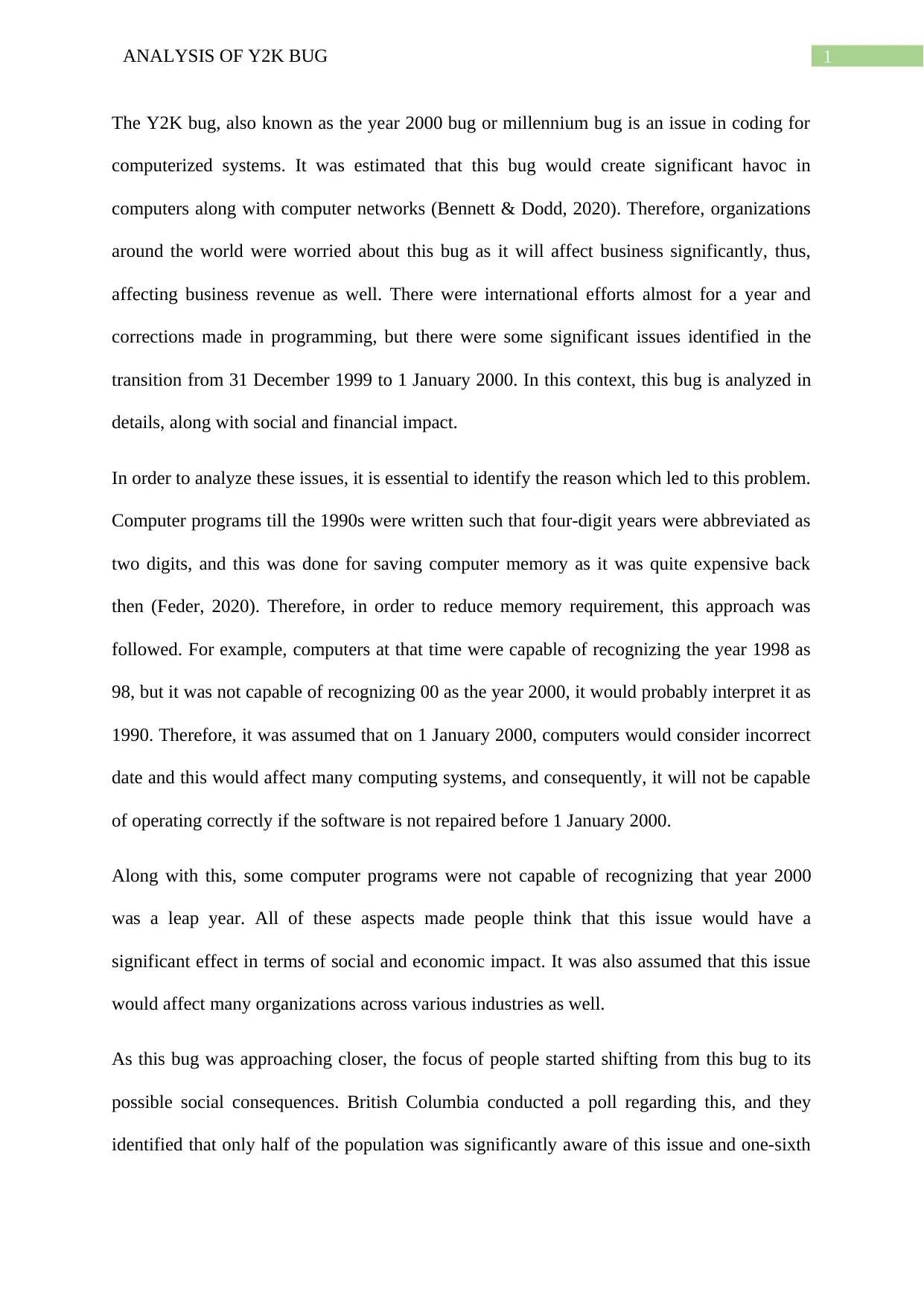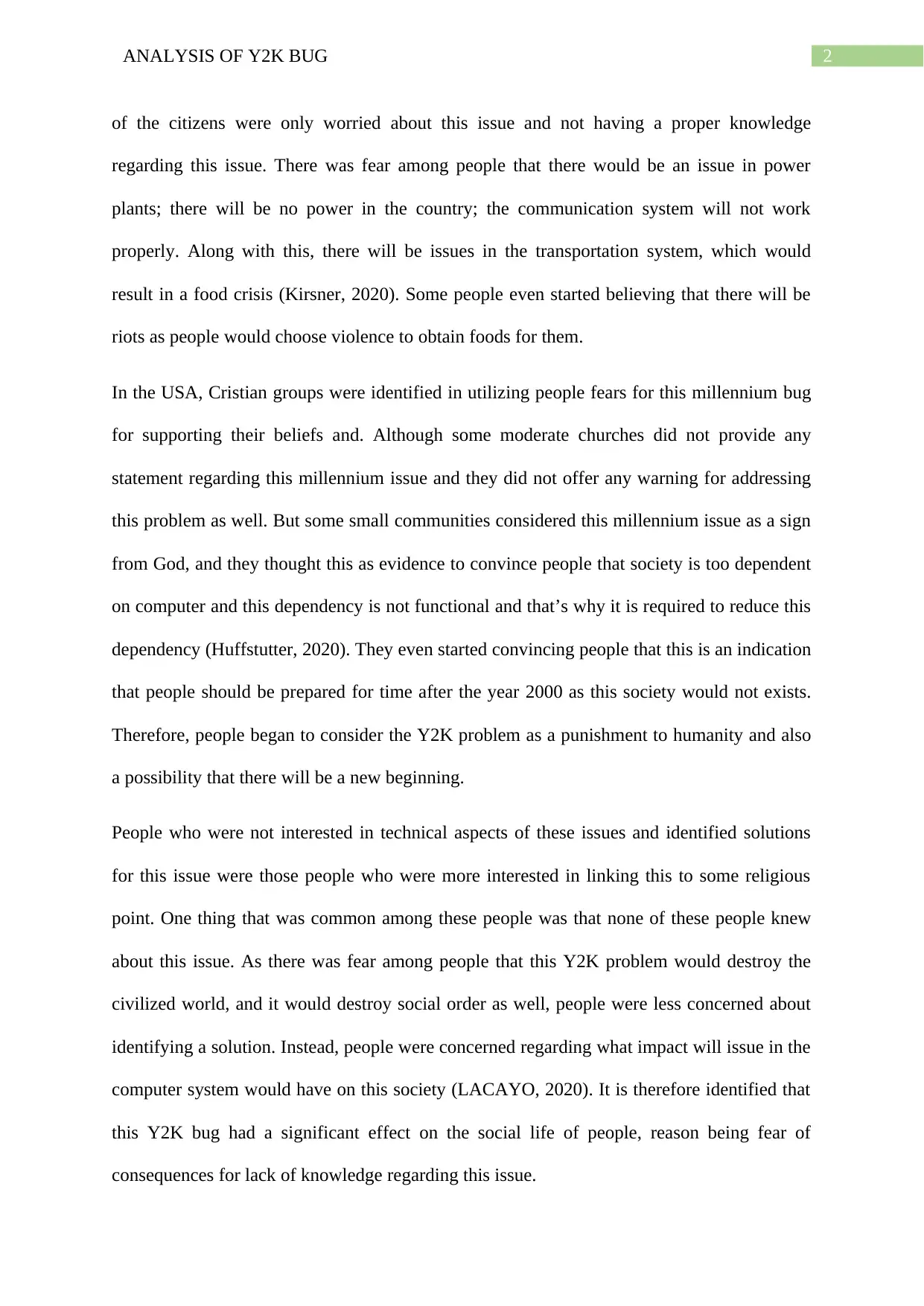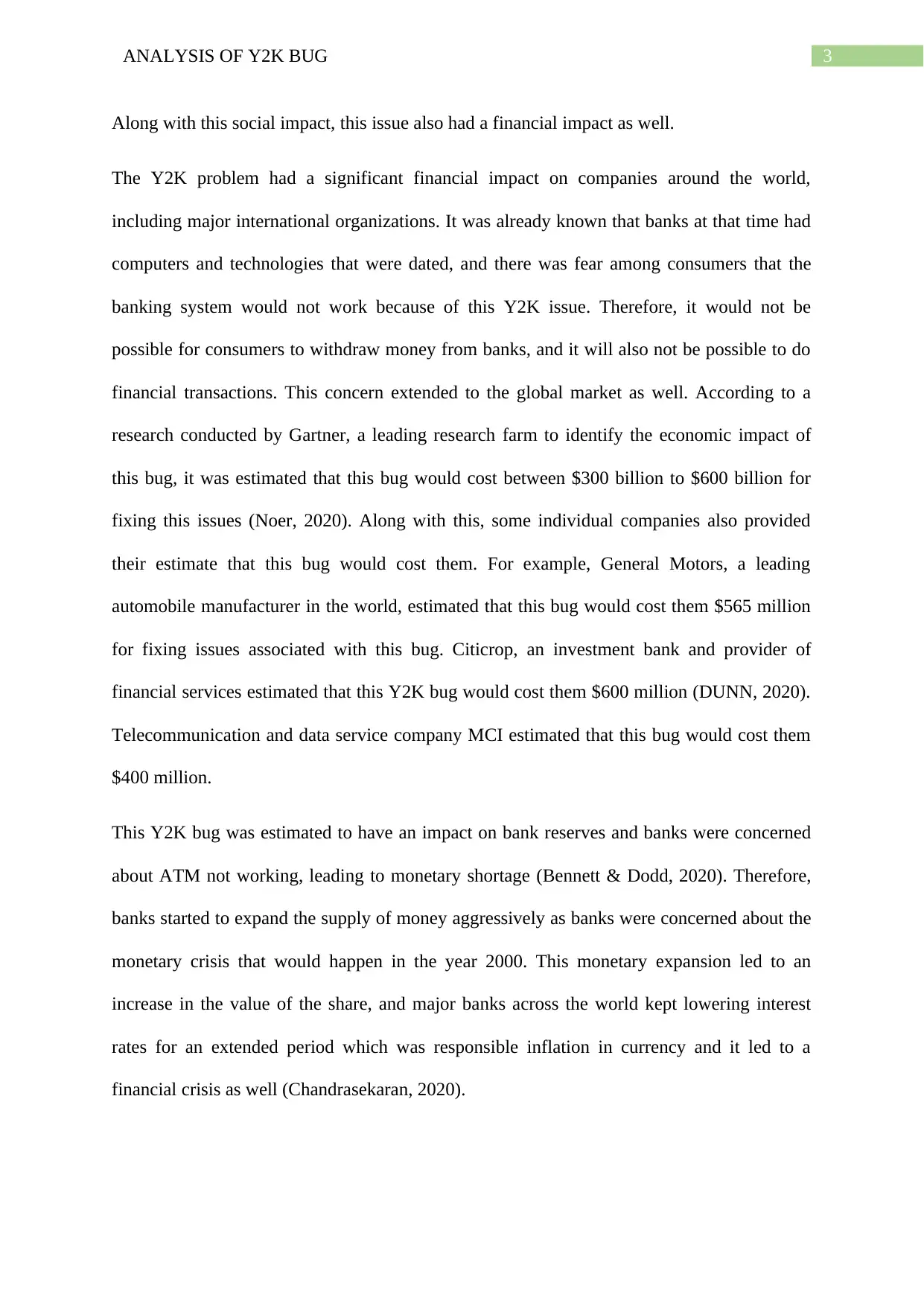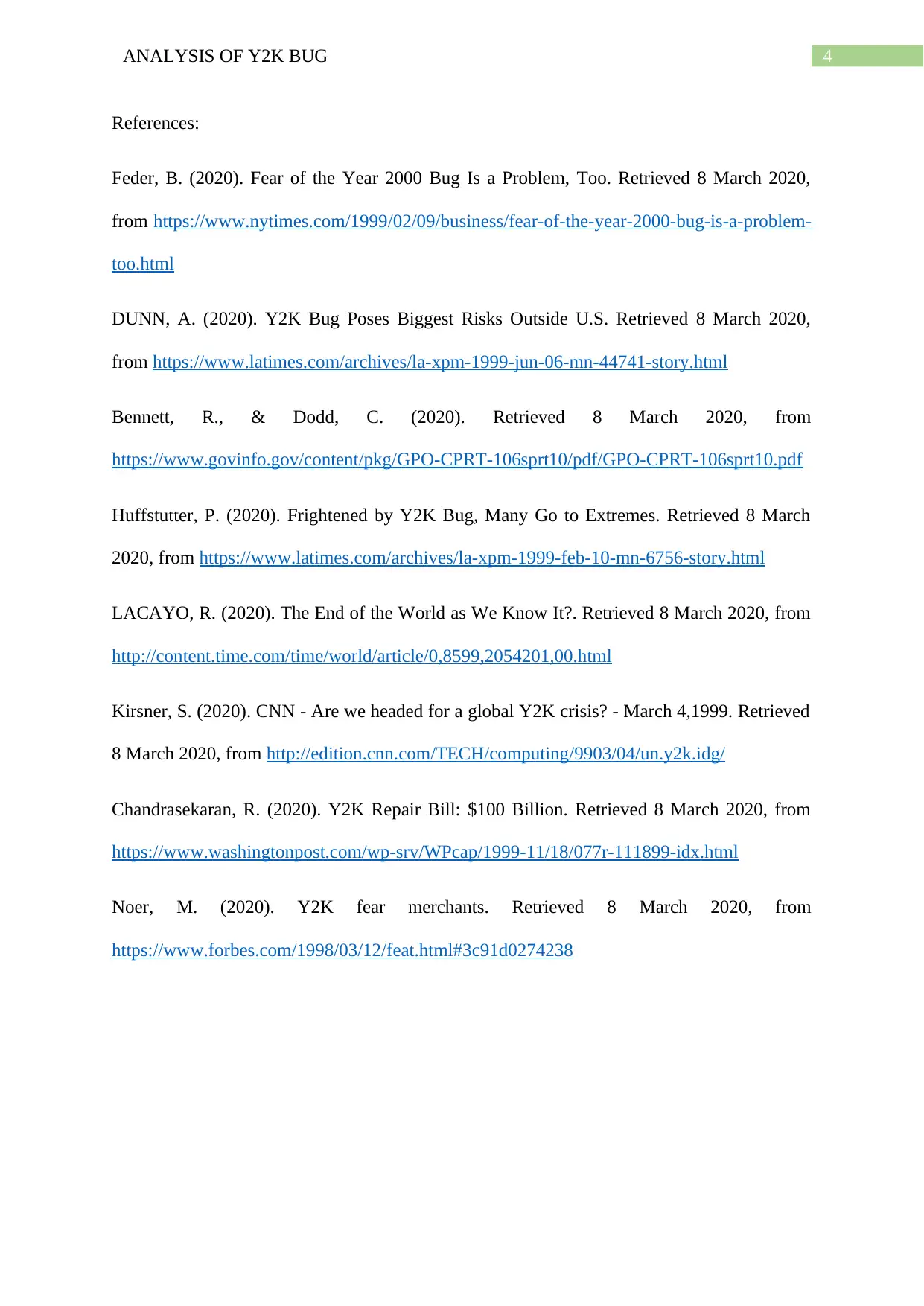Analysis of the Y2K Bug: Social, Economic, and Technical Aspects
VerifiedAdded on 2022/08/19
|5
|1380
|19
Report
AI Summary
This report analyzes the Y2K bug, also known as the year 2000 or millennium bug, a coding issue that threatened computerized systems. The report explores the origins of the bug, which stemmed from abbreviating four-digit years to two digits to save computer memory. It details the social impact, including public fear of power outages and communication failures, and the rise of religious interpretations of the issue. The report also examines the financial repercussions, such as the estimated $300 to $600 billion cost to fix the problem, the concerns of banks and financial institutions, and the resulting monetary expansion that contributed to inflation. The analysis highlights the widespread impact across various industries and the significant social and economic consequences of the Y2K bug.

Running head: ANALYSIS OF Y2K BUG
ANALYSIS OF Y2K BUG
Name of student
Name of university
Author’s note:
ANALYSIS OF Y2K BUG
Name of student
Name of university
Author’s note:
Paraphrase This Document
Need a fresh take? Get an instant paraphrase of this document with our AI Paraphraser

1ANALYSIS OF Y2K BUG
The Y2K bug, also known as the year 2000 bug or millennium bug is an issue in coding for
computerized systems. It was estimated that this bug would create significant havoc in
computers along with computer networks (Bennett & Dodd, 2020). Therefore, organizations
around the world were worried about this bug as it will affect business significantly, thus,
affecting business revenue as well. There were international efforts almost for a year and
corrections made in programming, but there were some significant issues identified in the
transition from 31 December 1999 to 1 January 2000. In this context, this bug is analyzed in
details, along with social and financial impact.
In order to analyze these issues, it is essential to identify the reason which led to this problem.
Computer programs till the 1990s were written such that four-digit years were abbreviated as
two digits, and this was done for saving computer memory as it was quite expensive back
then (Feder, 2020). Therefore, in order to reduce memory requirement, this approach was
followed. For example, computers at that time were capable of recognizing the year 1998 as
98, but it was not capable of recognizing 00 as the year 2000, it would probably interpret it as
1990. Therefore, it was assumed that on 1 January 2000, computers would consider incorrect
date and this would affect many computing systems, and consequently, it will not be capable
of operating correctly if the software is not repaired before 1 January 2000.
Along with this, some computer programs were not capable of recognizing that year 2000
was a leap year. All of these aspects made people think that this issue would have a
significant effect in terms of social and economic impact. It was also assumed that this issue
would affect many organizations across various industries as well.
As this bug was approaching closer, the focus of people started shifting from this bug to its
possible social consequences. British Columbia conducted a poll regarding this, and they
identified that only half of the population was significantly aware of this issue and one-sixth
The Y2K bug, also known as the year 2000 bug or millennium bug is an issue in coding for
computerized systems. It was estimated that this bug would create significant havoc in
computers along with computer networks (Bennett & Dodd, 2020). Therefore, organizations
around the world were worried about this bug as it will affect business significantly, thus,
affecting business revenue as well. There were international efforts almost for a year and
corrections made in programming, but there were some significant issues identified in the
transition from 31 December 1999 to 1 January 2000. In this context, this bug is analyzed in
details, along with social and financial impact.
In order to analyze these issues, it is essential to identify the reason which led to this problem.
Computer programs till the 1990s were written such that four-digit years were abbreviated as
two digits, and this was done for saving computer memory as it was quite expensive back
then (Feder, 2020). Therefore, in order to reduce memory requirement, this approach was
followed. For example, computers at that time were capable of recognizing the year 1998 as
98, but it was not capable of recognizing 00 as the year 2000, it would probably interpret it as
1990. Therefore, it was assumed that on 1 January 2000, computers would consider incorrect
date and this would affect many computing systems, and consequently, it will not be capable
of operating correctly if the software is not repaired before 1 January 2000.
Along with this, some computer programs were not capable of recognizing that year 2000
was a leap year. All of these aspects made people think that this issue would have a
significant effect in terms of social and economic impact. It was also assumed that this issue
would affect many organizations across various industries as well.
As this bug was approaching closer, the focus of people started shifting from this bug to its
possible social consequences. British Columbia conducted a poll regarding this, and they
identified that only half of the population was significantly aware of this issue and one-sixth

2ANALYSIS OF Y2K BUG
of the citizens were only worried about this issue and not having a proper knowledge
regarding this issue. There was fear among people that there would be an issue in power
plants; there will be no power in the country; the communication system will not work
properly. Along with this, there will be issues in the transportation system, which would
result in a food crisis (Kirsner, 2020). Some people even started believing that there will be
riots as people would choose violence to obtain foods for them.
In the USA, Cristian groups were identified in utilizing people fears for this millennium bug
for supporting their beliefs and. Although some moderate churches did not provide any
statement regarding this millennium issue and they did not offer any warning for addressing
this problem as well. But some small communities considered this millennium issue as a sign
from God, and they thought this as evidence to convince people that society is too dependent
on computer and this dependency is not functional and that’s why it is required to reduce this
dependency (Huffstutter, 2020). They even started convincing people that this is an indication
that people should be prepared for time after the year 2000 as this society would not exists.
Therefore, people began to consider the Y2K problem as a punishment to humanity and also
a possibility that there will be a new beginning.
People who were not interested in technical aspects of these issues and identified solutions
for this issue were those people who were more interested in linking this to some religious
point. One thing that was common among these people was that none of these people knew
about this issue. As there was fear among people that this Y2K problem would destroy the
civilized world, and it would destroy social order as well, people were less concerned about
identifying a solution. Instead, people were concerned regarding what impact will issue in the
computer system would have on this society (LACAYO, 2020). It is therefore identified that
this Y2K bug had a significant effect on the social life of people, reason being fear of
consequences for lack of knowledge regarding this issue.
of the citizens were only worried about this issue and not having a proper knowledge
regarding this issue. There was fear among people that there would be an issue in power
plants; there will be no power in the country; the communication system will not work
properly. Along with this, there will be issues in the transportation system, which would
result in a food crisis (Kirsner, 2020). Some people even started believing that there will be
riots as people would choose violence to obtain foods for them.
In the USA, Cristian groups were identified in utilizing people fears for this millennium bug
for supporting their beliefs and. Although some moderate churches did not provide any
statement regarding this millennium issue and they did not offer any warning for addressing
this problem as well. But some small communities considered this millennium issue as a sign
from God, and they thought this as evidence to convince people that society is too dependent
on computer and this dependency is not functional and that’s why it is required to reduce this
dependency (Huffstutter, 2020). They even started convincing people that this is an indication
that people should be prepared for time after the year 2000 as this society would not exists.
Therefore, people began to consider the Y2K problem as a punishment to humanity and also
a possibility that there will be a new beginning.
People who were not interested in technical aspects of these issues and identified solutions
for this issue were those people who were more interested in linking this to some religious
point. One thing that was common among these people was that none of these people knew
about this issue. As there was fear among people that this Y2K problem would destroy the
civilized world, and it would destroy social order as well, people were less concerned about
identifying a solution. Instead, people were concerned regarding what impact will issue in the
computer system would have on this society (LACAYO, 2020). It is therefore identified that
this Y2K bug had a significant effect on the social life of people, reason being fear of
consequences for lack of knowledge regarding this issue.
⊘ This is a preview!⊘
Do you want full access?
Subscribe today to unlock all pages.

Trusted by 1+ million students worldwide

3ANALYSIS OF Y2K BUG
Along with this social impact, this issue also had a financial impact as well.
The Y2K problem had a significant financial impact on companies around the world,
including major international organizations. It was already known that banks at that time had
computers and technologies that were dated, and there was fear among consumers that the
banking system would not work because of this Y2K issue. Therefore, it would not be
possible for consumers to withdraw money from banks, and it will also not be possible to do
financial transactions. This concern extended to the global market as well. According to a
research conducted by Gartner, a leading research farm to identify the economic impact of
this bug, it was estimated that this bug would cost between $300 billion to $600 billion for
fixing this issues (Noer, 2020). Along with this, some individual companies also provided
their estimate that this bug would cost them. For example, General Motors, a leading
automobile manufacturer in the world, estimated that this bug would cost them $565 million
for fixing issues associated with this bug. Citicrop, an investment bank and provider of
financial services estimated that this Y2K bug would cost them $600 million (DUNN, 2020).
Telecommunication and data service company MCI estimated that this bug would cost them
$400 million.
This Y2K bug was estimated to have an impact on bank reserves and banks were concerned
about ATM not working, leading to monetary shortage (Bennett & Dodd, 2020). Therefore,
banks started to expand the supply of money aggressively as banks were concerned about the
monetary crisis that would happen in the year 2000. This monetary expansion led to an
increase in the value of the share, and major banks across the world kept lowering interest
rates for an extended period which was responsible inflation in currency and it led to a
financial crisis as well (Chandrasekaran, 2020).
Along with this social impact, this issue also had a financial impact as well.
The Y2K problem had a significant financial impact on companies around the world,
including major international organizations. It was already known that banks at that time had
computers and technologies that were dated, and there was fear among consumers that the
banking system would not work because of this Y2K issue. Therefore, it would not be
possible for consumers to withdraw money from banks, and it will also not be possible to do
financial transactions. This concern extended to the global market as well. According to a
research conducted by Gartner, a leading research farm to identify the economic impact of
this bug, it was estimated that this bug would cost between $300 billion to $600 billion for
fixing this issues (Noer, 2020). Along with this, some individual companies also provided
their estimate that this bug would cost them. For example, General Motors, a leading
automobile manufacturer in the world, estimated that this bug would cost them $565 million
for fixing issues associated with this bug. Citicrop, an investment bank and provider of
financial services estimated that this Y2K bug would cost them $600 million (DUNN, 2020).
Telecommunication and data service company MCI estimated that this bug would cost them
$400 million.
This Y2K bug was estimated to have an impact on bank reserves and banks were concerned
about ATM not working, leading to monetary shortage (Bennett & Dodd, 2020). Therefore,
banks started to expand the supply of money aggressively as banks were concerned about the
monetary crisis that would happen in the year 2000. This monetary expansion led to an
increase in the value of the share, and major banks across the world kept lowering interest
rates for an extended period which was responsible inflation in currency and it led to a
financial crisis as well (Chandrasekaran, 2020).
Paraphrase This Document
Need a fresh take? Get an instant paraphrase of this document with our AI Paraphraser

4ANALYSIS OF Y2K BUG
References:
Feder, B. (2020). Fear of the Year 2000 Bug Is a Problem, Too. Retrieved 8 March 2020,
from https://www.nytimes.com/1999/02/09/business/fear-of-the-year-2000-bug-is-a-problem-
too.html
DUNN, A. (2020). Y2K Bug Poses Biggest Risks Outside U.S. Retrieved 8 March 2020,
from https://www.latimes.com/archives/la-xpm-1999-jun-06-mn-44741-story.html
Bennett, R., & Dodd, C. (2020). Retrieved 8 March 2020, from
https://www.govinfo.gov/content/pkg/GPO-CPRT-106sprt10/pdf/GPO-CPRT-106sprt10.pdf
Huffstutter, P. (2020). Frightened by Y2K Bug, Many Go to Extremes. Retrieved 8 March
2020, from https://www.latimes.com/archives/la-xpm-1999-feb-10-mn-6756-story.html
LACAYO, R. (2020). The End of the World as We Know It?. Retrieved 8 March 2020, from
http://content.time.com/time/world/article/0,8599,2054201,00.html
Kirsner, S. (2020). CNN - Are we headed for a global Y2K crisis? - March 4,1999. Retrieved
8 March 2020, from http://edition.cnn.com/TECH/computing/9903/04/un.y2k.idg/
Chandrasekaran, R. (2020). Y2K Repair Bill: $100 Billion. Retrieved 8 March 2020, from
https://www.washingtonpost.com/wp-srv/WPcap/1999-11/18/077r-111899-idx.html
Noer, M. (2020). Y2K fear merchants. Retrieved 8 March 2020, from
https://www.forbes.com/1998/03/12/feat.html#3c91d0274238
References:
Feder, B. (2020). Fear of the Year 2000 Bug Is a Problem, Too. Retrieved 8 March 2020,
from https://www.nytimes.com/1999/02/09/business/fear-of-the-year-2000-bug-is-a-problem-
too.html
DUNN, A. (2020). Y2K Bug Poses Biggest Risks Outside U.S. Retrieved 8 March 2020,
from https://www.latimes.com/archives/la-xpm-1999-jun-06-mn-44741-story.html
Bennett, R., & Dodd, C. (2020). Retrieved 8 March 2020, from
https://www.govinfo.gov/content/pkg/GPO-CPRT-106sprt10/pdf/GPO-CPRT-106sprt10.pdf
Huffstutter, P. (2020). Frightened by Y2K Bug, Many Go to Extremes. Retrieved 8 March
2020, from https://www.latimes.com/archives/la-xpm-1999-feb-10-mn-6756-story.html
LACAYO, R. (2020). The End of the World as We Know It?. Retrieved 8 March 2020, from
http://content.time.com/time/world/article/0,8599,2054201,00.html
Kirsner, S. (2020). CNN - Are we headed for a global Y2K crisis? - March 4,1999. Retrieved
8 March 2020, from http://edition.cnn.com/TECH/computing/9903/04/un.y2k.idg/
Chandrasekaran, R. (2020). Y2K Repair Bill: $100 Billion. Retrieved 8 March 2020, from
https://www.washingtonpost.com/wp-srv/WPcap/1999-11/18/077r-111899-idx.html
Noer, M. (2020). Y2K fear merchants. Retrieved 8 March 2020, from
https://www.forbes.com/1998/03/12/feat.html#3c91d0274238
1 out of 5
Your All-in-One AI-Powered Toolkit for Academic Success.
+13062052269
info@desklib.com
Available 24*7 on WhatsApp / Email
![[object Object]](/_next/static/media/star-bottom.7253800d.svg)
Unlock your academic potential
Copyright © 2020–2025 A2Z Services. All Rights Reserved. Developed and managed by ZUCOL.
